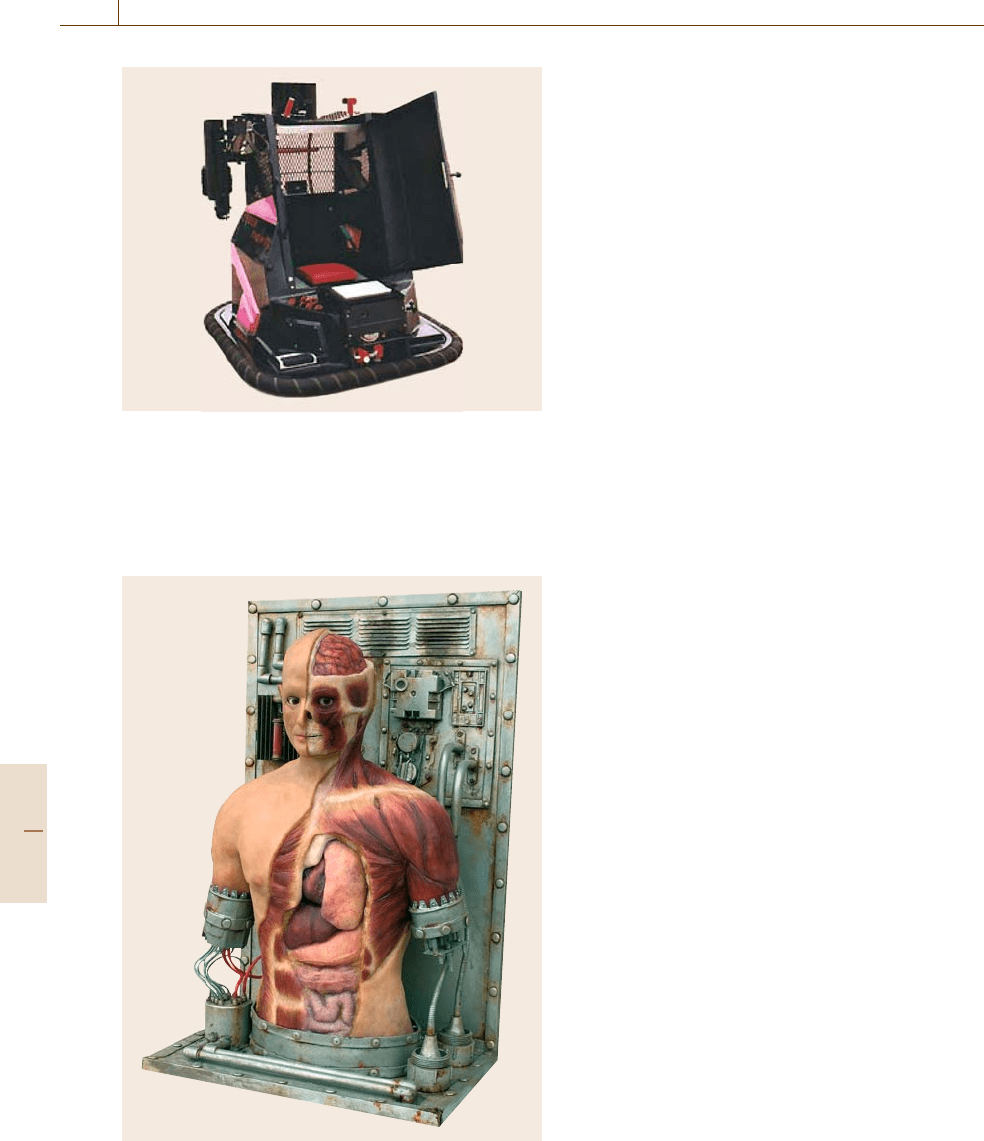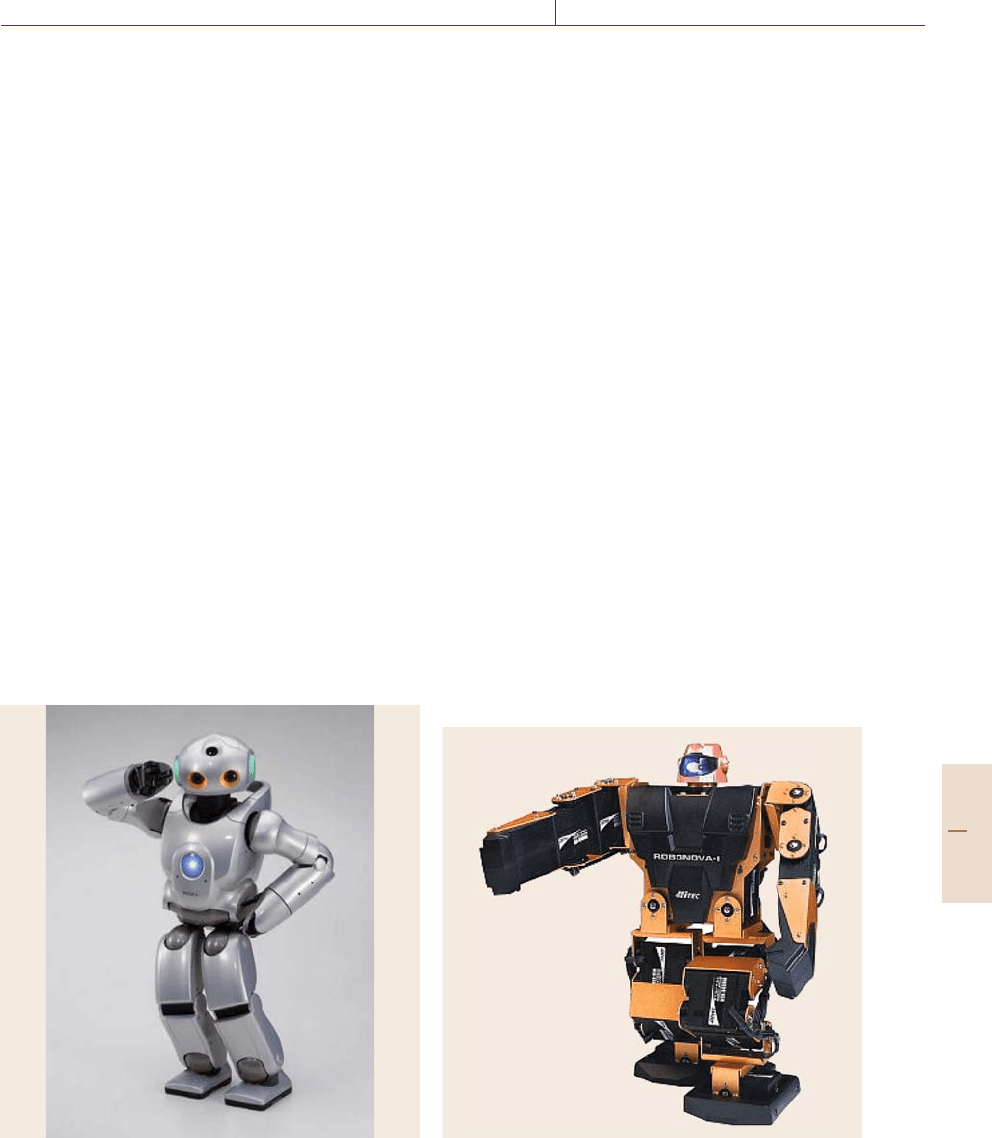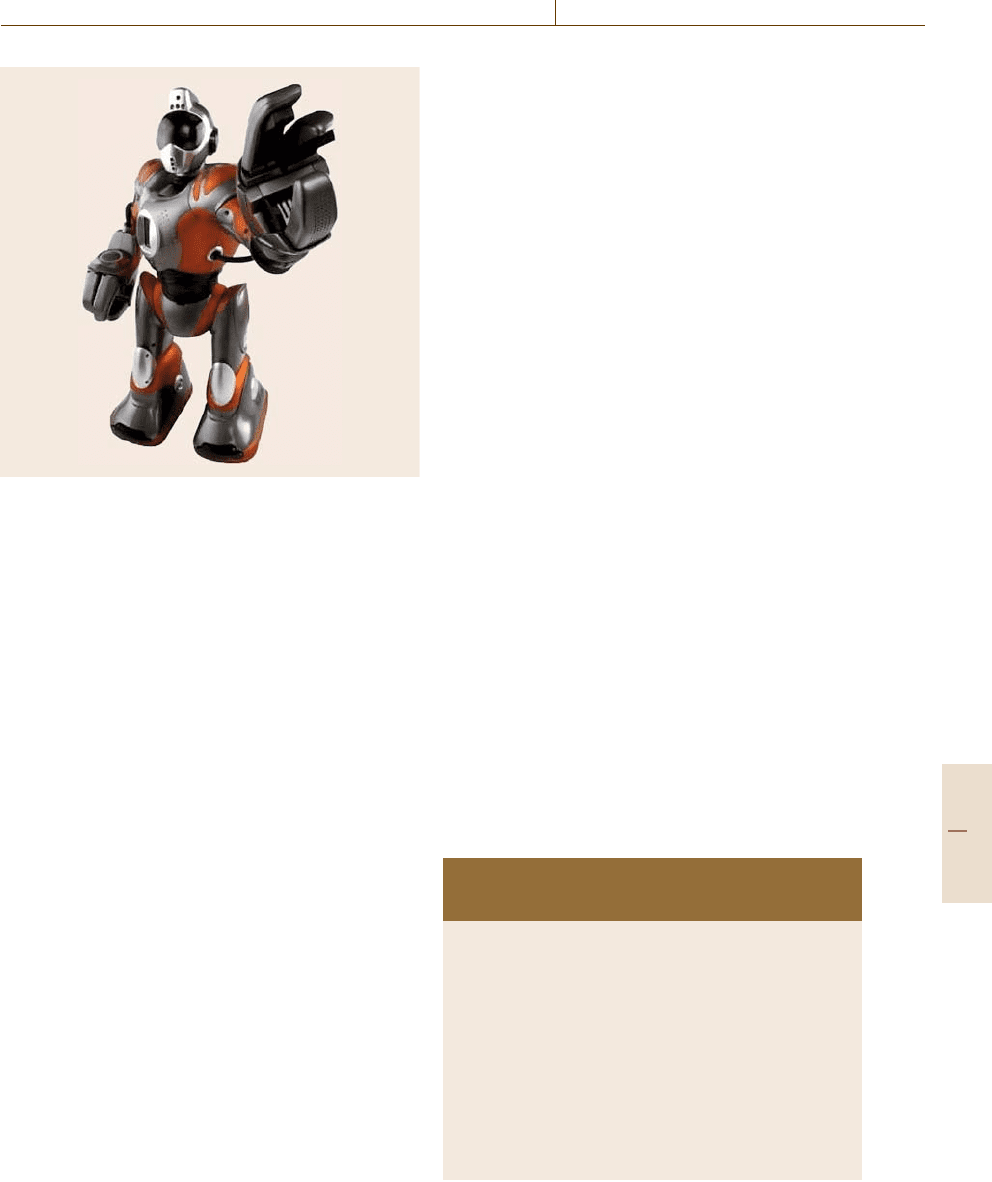Nof S.Y. Springer Handbook of Automation
Подождите немного. Документ загружается.


Automation in Sports and Entertainment 74.1 Robots in Entertainment, Leisure, and Hobby 1315
74.1 Robots in Entertainment, Leisure, and Hobby
One of the newest application areas of service robots is
in thefield ofentertainment, leisure,and hobby, because
people have more free time, and modern information
technologies lead to loneliness of humans (teleworking,
telebanking, teleshopping, etc.). We need robots to as-
sist, support, and join humans. The field of robots in
entertainment, leisure, and hobby was therefore born.
The roots of such robots go back more than 20years
ago [74.3, 4]. These robots are usually mobile, intel-
ligent, and cooperative. The idea of making modern
automation transparent for a broaderpublic goesback to
the middle of the 19th century. One tool for this is play-
ing with automation. First examples were in the field of
process automation, e.g., two- and three-tank systems,
model railways, model racing cars, etc. At the end of
the 19th century and the beginning of the 20th century
robots started to attract a broader public. One of the rea-
sons for this is humans’ long-time dream of having an
intelligent machine looking and acting like us. There-
fore robots are currently and will be also in the future
high-tech toys for playing with automation.
In the past construction sets for stationary, indus-
trial robots served for playing with robots. These model
robots were a popular gift not only for children. Ap-
proximately 30years ago the first construction kits for
mobile and also humanoid robots appeared on the mar-
ket. Currently and also in the future the development of
entertainment robots is closely connected to the devel-
opment of real, mobile, intelligent, especially humanoid
robots. Most of the advanced theories implemented in
these real robots are and will be the basis for enter-
tainment and play robots. The main problem can be
summarized under the headline cost-oriented automa-
tion (COA). These robots must be available on the
market for a reasonable selling price.
74.1.1 Definitions
First it is certainly important to take a brief look at dif-
ferent definitions of the terms entertainment, leisure,
and hobby. Their meanings often overlap, but neverthe-
less they all mean something different.
Entertainment
This can be defined as: the act or profession of en-
tertaining, i. e., to amuse and interest, especially by
public performance and keeping the attention of peo-
ple watching or listening [74.5]; the act of entertaining,
or something diverting or engaging as a public perfor-
mance, e.g., a (usually light) comic or an adventure
novel [74.6].
Leisure
This can be defined as: time when one is free from work
or duties ofanykind; free time [74.5]; freedomprovided
by the cessation of activities; especially time free from
work or duties [74.6].
Hobby
This can be defined as: an activity which one enjoys
doing in one’s free time [74.5]; a pursuit outside one’s
regular occupation, engaged in especially for relax-
ation [74.6].
74.1.2 Categories
Due to thebroad range ofpossible applications ofrobots
in entertainment, leisure, and hobby, the following clas-
sification [74.3] has been made in order to give this
chapter its basic structure:
•
Robot construction sets
•
Sports assistants
•
Robots for promotion and public relations
•
Robots in entertainment industry
•
Personal robots
•
Humanoid robots
•
Competition robots.
74.1.3 Examples
In the following some classical examples, because of
the rapid development in this field, are presented and
shortly discussed.
Robot Construction Sets
These construction sets often stem from conventional
technical construction sets that have been upgraded
using sensor and microcontroller technology, paired
with computer interfaces to allow the user to run
self-programmed software. They are mainly for com-
puter enthusiastsfor testing own-developed software on
a cheap hardware.
There are two main types of construction kits
available:
•
Sets where it is possible to construct various robots
•
Sets where only one robot can be constructed
Part G 74.1

1316 Part G Infrastructure and Service Automation
Within these main categories it is also possible to
choose from awide variety of different kits; pricesrange
from under US$100 to several hundred USdollars.
The well-known system in the first category is Lego
Mindstorms [74.7]. Based on the products of this com-
pany, the construction set allows a great variety of
possible assemblies due to its modular structure. The
only limit is the fantasy of the constructor. The sys-
tem consists is of a specially developed microcomputer
(the heart of Lego Mindstorms), software, 717 elements
(bricks, connectors, wheels, and gears), 2 motors, 2
touch sensors, 1 light sensor, and an infrared transmitter
for sending programs to the robots.
Mobile Robots is a construction set for sensor-
guided robots. The included robot–personal computer
(PC) interface allows one to write ones own command
routines on the computer and load them into the robot’s
memory. Sothe robot can act independentlyand without
any attached cables. Possible constructions are capable
of detecting edges and stopping before falling down,
are aware of obstacles, and can follow light sources or
track plotted lines. As it is a totally flexible system, own
creations are possible and appreciated.
Representatives of the second category are robots
from a company offering a wide variety of construc-
tion kits, but all of them designed for building one
robot only. Various models of robotic arms, bipeds,
quadrapods, hexapods, polypods, carpet rovers, four-
wheel-drive (4-WD) rovers, and sumo robots are
available.
Sports Assistants
The robots introduced into this field are systems well
equipped with high-tech sensors that assist humans in
their favorite sport by performing routine tasks usually
annoying such as collecting tennis balls or carrying golf
clubs.
Tennis Ball Collector: Jeeves. Developed by a free-
lance designer in cooperation with a university, this
robot collects tennis balls bydrivingtowards themwhen
detected by the onboard charge-coupled device (CCD)
camera, and bringing them into a basket in the rear us-
ing a rotating brush. Ultrasound distance sensors avoid
collisions with obstacles on the court while the robot
generates a map of the environment based on its sen-
sor data and stores this information for further use,
thus enabling Jeeves to sweep an already known court
effectively. Path planning is done by a sophisticated
computer system running on an off-board workstation
that is connected via a radio link.
Golf Caddy: InteleCaddy. This robot replaces a hu-
man caddy in a mass sport application where many
golfers are not willing to pay for a caddy, currently
being installed at golf courses all over the world. The
InteleCaddy is a computer-controlled, electrically pow-
ered golf caddie robot that navigates around the golf
course with its telecommunication skills and sensors,
being connected to the golfer via a small pager-sized
coded transmitter. The robot features a digital aerial
map ofthe golfcourse and is programmed to stay within
preset boundaries, thus following the golfer with the
bags using geographical positioning system (GPS)and
ultrasound sensors for navigation and obstacle avoid-
ance. As a bonus, the computer also supplies the golfer
with useful information on the course such as exact dis-
tance to predefined positions (greens, bunkers, and tees)
on the map.
Robots for Promotion and Public Relations
Robots for promotion and public relations can be di-
vided into the categories of tour guide robots and
performance robots, hence having very different tasks.
Tour guide robots give information to people while
interacting with them, thus attracting and entertaining
prospective visitors as well. Performance robots are for
performances in public places or at events, mostly with
robot systems rented by specialized companies.
Tour Guide Robots. A tour guide robot has to be able to
move aroundautonomously in theenvironment. It has to
acquire the attention of visitors and interact with them
efficiently in order to fulfil its main goal: give the vis-
itors a predefined tour. These robots were designed to
conduct guided tours in public places such as museums
Fig. 74.3 Museum tour guide Minerva
Part G 74.1

Automation in Sports and Entertainment 74.1 Robots in Entertainment, Leisure, and Hobby 1317
Fig. 74.4 Museum tour guide Twiddling, Inciting, Instruc-
tive
while managing autonomous sensor-based navigation
as well as avoidanceof collisions in a densely populated
area of unpredictable moving visitors.
The tasks of a tour guide robot are:
•
Traveling from one exhibit to the next during the
course of the tour
•
Attracting visitors to participate in a new tour be-
tween tours
•
Engaging people’s interest and maintaining their at-
tention while describing a specific exhibit.
Furthermore, they are equipped with social interac-
tion features, which range from rather simple voice
output (RHINO) [74.10] to a combination of voice, fa-
cial expressions, and a model to express feelings as
well (Minerva), giving the robot a human touch. The
navigation system of both units is based on real-time
processing of sensor data to generate a map of the
environment.
Minerva[74.11] was developedin 1998by Carnegie
Mellon University and the University of Bonn and
is working in the Smithsonian’s National Museum of
American History, USA.
These robots, developed by Fraunhofer IPA,
Stuttgart, have been in use in the Museum für Kommu-
nikation in Berlin, Germany since 2000.
Performance Robots. The main task of performance
robots is to entertain people, often using low-tech ap-
plications with a few sensors, limited computing power,
and no capabilities to act autonomously. Systems such
as Robosaurus or Boxerjocks can be rented for large
public events to attract visitors and thus increase the
revenue of the renter.
Fig. 74.5 Megasaurus [74.8]
Due to the existence of a large number ofcompanies
renting or distributing performance robots, just a few
applications have been included in order to give a short
survey of how broad the range of entertainment robots
or animatronic systems is in this field.
Megasaurus and Transaurus are modeled after
a Tyrannosaurus rex and have hydraulically activated
arms, grasping claws, and jaws, as well as flame throw-
ers set up in the head to give the effect of breathing
fire from the mouth. They both fold up into a ve-
hicle based on a tank and when the robots perform
they initially appear as a box on tracks decorated as
either a military vehicle (Megasaurus) or a dinosaur
(Transaurus). Each robot is roughly 30feet tall at maxi-
mum extension. They are used primarily to destroy cars
by eating them (ripping them apart with the claws and
jaws) at motor sport events, especially monster truck
competitions.
Fig. 74.6 Transaurus [74.9]
Part G 74.1

1318 Part G Infrastructure and Service Automation
Fig. 74.7 Boxer Jack [74.12]
Boxer Jacks Robotic Boxing is an animatronics sys-
tem that serves as an attraction in amusement parks
or other places where large crowds of people can be
found, such as shoppingcenters. The application system
Fig. 74.8 Jekyll and Hyde animatronic (courtesy of Life
Formations [74.12])
is fairly straightforward: Two of theserobots are located
within a certain area wherethey can move aroundfreely.
Each of the systems is controlled by a human, who tries
to punch the other’s robot. Technical features include:
•
Construction – Tubular steel network with a rigid
steel mesh surrounding the rider’s upper body, pro-
viding ample safety and visibility
•
Drive – Dependable Honda gasoline engine pow-
ers the hydropneumatic system for mobility and arm
punching articulations
•
Body – Hand-laid fiberglass with choice of color
scheme; quality urethane enamel finishes used
•
Seating – Designed so that riders aged 8years
through to adults can operate a Boxerjack easily
•
Impact areas – Use of heavy rubber on all contact
areas, bumper, gloves, and arms cushion all shock
loadings during the match
•
Electrical – 12V direct-current (DC) battery system
use for arm switching, scoreboard, and head horn.
Robots in the Entertainment Industry
Robot applications in the film industry are often spec-
tacular because of their custom-made special features.
In thischapter robotsas performing artists, can be found
as well.
Film Industry. Starting with Metropolis in 1926, deal-
ing witha futuristic city and its mechanized society with
humans being replaced by a robot, through The Day
the Earth Stood Still (1951), Lost in Space (1965) to
A Space Odyssey, robots have frequently been used in
films.
One of the most recent examples in movies is I-
robot; although not based on the the book written by
Asimov, it was based on the concepts proposed therein,
such as the three laws of robotic behavior. It presents
a future where robots do all manual labor. One robot
is programmed and trained to understand human emo-
tions, and commits murder due to a promise and out
of love. The robots take over as they get deeper under-
standing of the three laws – mankind is destroying itself
and has to be protected from self-destruction.
As the entertainment industry was one of the first
fields to use service robots, there is a huge variety of ap-
plications in theme parks and especially movies, where
robotic and animatronic creatures are often combined
with animated computer graphics to realize spectacular
special effects (Figs. 74.8–74.10).
Another field of robotic applications is in the per-
forming arts, where robots can be found rather seldom,
Part G 74.1

Automation in Sports and Entertainment 74.1 Robots in Entertainment, Leisure, and Hobby 1319
but therefore in mostly amazing performances that
partly have a scientific background as well.
Robotic Snake in Anaconda. This lifelike replica
of the giant Anaconda is a high-tensile-steel robot
structure, consisting of individually controlled artifi-
cial vertebrae that are driven by hydraulic cylinders.
The system is controlled by more than 70 coupled
microprocessors with a special control concept that
allows the underlying hydraulic system to perform
the necessary quick movements of the heavy struc-
ture.
Robots in Jurassic Park. The roboticsystem incorporat-
ing the Tyrannosaurus, the largest one ever built for use
in a movie, is a fiberglass frame construction covered by
clay andafterwards coated with a specially painted latex
skin. As the robot measured 9m high and weighed 10t,
it had to be supported by a massive foundation usually
used for flight simulators.
Other less spectacular systems such as the replica of
a Triceratops, featuring remotely controlled motors and
Fig. 74.9 Lincoln library (Springfield, IL) animatronics
(courtesy of Life Formations)
a mechanism to imitate breathing movements, were also
used in the movie.
Robots as Performing Artists. The robot band in-
troduced here is a pretty low-tech application for
entertainment purposes that plays digital music from
a computer disk while the animated robotic figures pre-
tend to move to the sound and play their instruments.
Although the Ullanta Performance Robots seem at
first sight to exist solely for entertainment, these fully
autonomous robots are used for research in cooperative
robot group behavior and multiagent systems as well,
both employed in a dynamic environment. These robots
are, within certain boundaries, allowed to interpret the
script based on their own software.
Personal Robots
Pet Robot: Furby. Being the ancestor of all pet robots,
this popular animatronic pet is equipped with a com-
puter chip, various sensors, and a small motor. It
responds to its environment in Furbish, a nonsense lan-
Fig. 74.10 Rolling Hills, Kansas Museum animatronics
(courtesy of Life Formations)
Part G 74.1

1320 Part G Infrastructure and Service Automation
guage, and is able to communicate with other Furbies
via infrared signals.
Personal Robot: R100. This prototype mobile personal
robot uses a completely new voice-controlled approach,
thus providing a more natural, buttonless interface in
order to become a real family member.
With its visualand voice recognition technologyand
Internet connectivity, it can be used as a voice mes-
sage or home security system (besides its function as
a personal companion).
Catrobot: Tama. Featuring speech output and recogni-
tion, thiskitten-like pet robotserves as a companion and
information source for senior citizens, while being re-
motely accessible by health or social workers who thus
can take care of the elderly without too much intrusion
into their privacy.
Robodog: i-Cybie. Described as “a watered-down
version of AIBO with almost the same functions with-
out the finesse” in the press, this infrared-controllable
robot dog indeed features many of AIBO’s functions
at a technically lower level but for a fraction of the
price.
Robodog: AIBO. AIBO is an abbreviation for artificial
intelligence robot. Because of its reduced instruction
set computer (RISC)-processor-powered high-tech sys-
tem including numerous sensors, a color camera, and
18 motors to move its extremities it is the first enter-
tainment robot that can think, feel, and act by itself. It
can walk and play, sit, and stretch like dogs and cats.
AIBO’s brain contains an emotion model to handle feel-
ings and aninstinct model to handle drives.The emotion
model covers six feelings: happiness, sadness, anger,
surprise, fear, and dislike. The instinct model has four
components: love, search, movement, and hunger.
Pet Robot: My Real Baby. This interactive, animated
doll features instant, sophisticated, and interactive
emotion-like responses and is able to simulate a mat-
uration and speech development process.
Humanoid Robots
Entertainment robots are expected to be one of the real
frontiers of the next decade. According to latest esti-
mations millions of such robots will be in use in the
coming years. The newest developments are friendly
robots for humans; for example, elderly people need lis-
tening and talking friends. We now have dogs, cats, and
human-like robots available for reasonable prices, but
not really humanoid robots walking on two legs [74.13].
First examples are described below.
Since 1986 theJapanese Company Hondahas devel-
oped humanoid robots, P2, P3, and ASIMO (advanced
step in innovation mobility). The basic idea is to inte-
grate intelligence and moving capability into a robot
for trivial tasks. Over the years the robot has become
smaller (from 160cm for P3 to 120cm for ASIMO)and
lighter (from 130kg of P3 to 43 kg of ASIMO). The
newest development is ASIMO. It can move at up to
1.6km/h and has 26 degrees of freedom (DOFs). This
kind of robot can easily be used in home as wheel-
driven robots, because of their ability to move over an
uneven surface such as stairs.
Therefore service robots will become a real partner
of humans in thenear future.One dream of the scientists
is the personal robot. In 5, 10 or 15years everybody
should have at least one such robot. Because the term
personal robot is derived from personal computer the
prices should be equal. Some new ideas in automation,
especially in robotics, are realized very quickly while
others disappear.
Honda is trying to build the ASIMO robot to be
a partner for people. So far it is merely a study about
how to imitate humans’ movements and make it able
to help people somehow. It is 120cm high, which is
enough to reach most gadgets designed for humans. The
latest model, introduced in December 2004, can even
run at 3km/h like a human.
QRIO is Sony’s [74.14] next step after the robodog
AIBO in entertainment robots. It’s a bipedal humanoid
robot that is able to:
•
Walk on uneven and sloppy surfaces
•
Run
•
Jump
•
Perceive depth through its two CCD cameras
•
Create a three-dimensional (3-D) map of its sur-
roundings
•
Recognize people from their faces and voices
•
Learn
•
Connect to the Internet via a wireless home network
•
Download and read information it thinks you’re in-
terested in
•
Sing
•
Dance
•
Survive a fall unscathed and get back up again by
itself.
In order for QRIO (Fig.74.11) to walk and dance
so skillfully, an actuator was needed with the ability to
Part G 74.1

Automation in Sports and Entertainment 74.1 Robots in Entertainment, Leisure, and Hobby 1321
produce varying levels of torque at varying RPM speeds
and respond with quickness and agility.
The robot moveswith dynamicwalking. Staticwalk-
ing means that the robot keeps its center of gravity
within the zone of stability – when the robot is stand-
ing on one foot, its center of gravity falls within the sole
of that foot, and when it is standing on two feet it falls
within a multisided shape created by those two feet –
causing it to walk relativelyslowly. In dynamicwalking,
on the other hand, the center of gravity is not limited to
the zone of stability – in fact it often moves outside of it
as the robotwalks. People move using dynamicwalking.
If pushed by someone, QRIO will take a step in the
direction in which it was pushed to keep from falling
over. When it determinesthat its actions will not prevent
a fall, it instinctively sticks out its arms and assumes an
impact position. After a fall, it turns itself face up, and
recovers from a variety of positions. It is equipped with
a camera and the ability to analyze the images it sees.
It detects faces and identifies who they are. Moreover
QRIO can determine who is speaking by analyzing the
sounds it hears with its built-in microphones.
An example of a reasonable cheap entertainment
robot is the humanoid robot of Robonova [74.15]. This
robot offers educators, students, and robotic hobbyists
a complete robot package. It is a fully customizable
and programmable aluminum robot (Fig.74.12). Six-
teen digital servos and joints give complete control of
Fig. 74.11 QRIO
torque, speed, and position. The programming software
is simple, so advanced knowledge of programming is
not needed. It can walk, run, do flips, cartwheels, and
dance. The robot is available as a kit – assembly time
approximately 8 h – or preassembled, ready to walk
robot. In addition to the typical robot talent of walking
until it senses a wall using ultrasound, Robonova can
be instructed to do cartwheels, take a bow, and even do
one-handed pushups.
The simplest way for programming is with the
catch-and-play function. With RoboScript or RoboBa-
sic the robot is moved to any position and by mouse
click that position is captured. The software then links
these captured positions and, once activated, smoothly
transitions the robot’s movements through these pro-
grammed positions.
For beginners in robot programming two software
packages are available. With these the users can create
operational subroutines without knowing any program-
ming language at all. The computer screen displays
sliders for every individual servo (joint). Moving the
sliders changes the position of the servos. Simple
movements can then be assembled to produce com-
plex movements simply by clicking the mouse. These
movements can then be called up on a graphical user
interface.
For more advanced users a programming tool based
on the Basic programming language is available. This
enables the users to create complex applications de-
Fig. 74.12 Robonova
Part G 74.1

1322 Part G Infrastructure and Service Automation
signed to accomplish their own individual tasks. The
independent development environment includes an ed-
itor and compiler. Commands for synchronous servo
movements, servo point-to-point movements, and servo
motion feedback are also available. The robot can be
extended with several accessory modules and items:
additional servos and brackets, gyros, acceleration
sensors, speech functions, remote control (RC) acces-
sories, and more can also be added as they become
available.
The RoboSapien (Fig. 74.13a) is a toy-like ro-
bot [74.16] preprogrammed with moves, which can also
be controlled by an infrared remote control included
with the toy, or by either a personal computer equipped
with an infrared transmitter, or an infrared-transmitter-
equipped personal digital assistant (PDA). The toy is
capable of walking motion without recourse to wheels
within its feet. It is also able to grasp objects with ei-
ther of its hands, and is also able to throw grasped
objects with mild force. It has a small loudspeaker unit,
which can broadcast several different vocalizations, all
of which appear to be recordings of a human male pre-
tending to be a great ape, such as a gorilla.
The toy’s remote control unit (Fig.74.13b) has a to-
tal of 21 different buttons. With the help of two shift
buttons, a total of 67 different robot-executable com-
mands are accessible.
The remote controller is equipped with a basic
level of programmability. Users can string together
a) b)
Fig. 74.13 (a) RoboSapien, (b) remote control
Fig. 74.14 RoboSapien V2
movement commands to form what the toy’s manual
describes as either macros or mini-programs, but which
are more correctly described as robotic instructions sets.
It is also possible to produce a sensor-keyed instruction
set.
The original robot was developed in the year 2000
and was a brilliant achievement of breakthrough design.
It could walk, grasp, and respond – in human-like ways.
Part G 74.1

Automation in Sports and Entertainment 74.1 Robots in Entertainment, Leisure, and Hobby 1323
Fig. 74.15 RS Media
The next generation (Fig.74.14) was released in 2003
and is nearly twice the size of the original robot. In-
stead of the original caveman grunts the V2 can speak
a reasonably large list of prerecorded phrases. It has in-
frared and basic color recognition sensors, grip sensors
in its hands, touch- or contact-activated hand and foot
sensors, and sonic sensors. For movement the V2 has an
articulated waist, shoulders, and hands, giving it a wide
variety of impressive body animations.
The latest model, the RS Media (Fig.74.15), which
was released in October 2006, uses basically the same
body as V2, but a different brain based on a Linux
kernel. As the name implies, RS Media’s focus is on
multimedia capabilities, including the ability to record
and playback audio, pictures, and video.
Another example of a reasonable cheap entertain-
ment robot is a 12inch-high robot that can walk, run,
and do flips, cartwheels, and dance moves, and that,
once programmed, is ready to compete in distinct com-
petitions. This fully articulating humanoid is controlled
by a control board, which can operate up to 24 servos
and 16 accessory modules with 16 digital servos.
Optional devices will eventually include gyros,
acceleration sensors, speech synthesis modules, and op-
erational devices such as Bluetooth controllers and R/C
transmitters and receivers. The operation time with a
five-cell rechargeable battery pack is approximately 1 h.
The main problem with such robots consists in the
preprogrammed movementsand thatit is not easy to add
some software modules.
Competition Robots
A very popular group of entertainment robots are those
for competitions. A robot competition is an event where
robots have to accomplish a given task. Usually they
have to beat other robots in order to be judged the best.
Most competitions are for schools but, as time goes by,
several professional competitions are arising. There is
a wide variety of competitions [74.17] for robots of var-
ious types. The following examples describe a few of
the higher-profile events.
The idea of a robot competition is not new; they
have been held for several years at, for example, the
Massachusetts Institute of Technology (MIT) in Boston
and Eidgenössische Technische Hochschule (ETH)in
Zurich. Having a robot competition in an academic
curriculum is highly beneficial, as it gives students
open-ended problem spaces, teaches them to work in
groups (of two or three persons), and stimulates creativ-
ity [74.18].
Classical examples are:
•
Robot outdoor tournaments
•
Robot soccer
•
Ping-pong-playing robots
•
Robot wrestling
•
Sumo wrestling robots
•
Billiard robots.
Table 74.1 gives some examples of robot games.
RoboGames. RoboGames [74.19] (previously ROB-
Olympics) is an annual robot contest held in San
Francisco, California. RoboGames is the world’s largest
Table 74.1 Examples of robot games
Beam robot games/olympics Robofesta official
games
Solarroller High/long jump Robocup
Photovore Legged race Robot grand prix
Aquavore Innovation All Japan sumo
machine tournament
Rope Robot-art All Japan
climbing micromouse
contest
Robot sumo Micromouse
Nanomouse Aerobot compet.
Part G 74.1

1324 Part G Infrastructure and Service Automation
open robot competition. They invite the best minds
from around the world to compete in over 70 different
events. About two-thirds of the robot events are au-
tonomous, while the remaining one-third are remotely
operated.
The first goal is to bring builders from com-
bat robotics (mechanical engineering), soccer robotics
(computer programming), sumo robotics (sensors), an-
droids (motion control), and art robots (aesthetics)
together for exchange experiences. The second goal is
to offer recognition to engineers from around the world
in varying disciplines with consistent rule sets and low
cost or without contestant fees. There are no prerequi-
sites forcontests; the event is open to anyone, regardless
of age or affiliation. Twenty-eight countries competed
with more than 800 robots in 2007.
Competition categories:
•
Combat:
– Categories from 1 to 340lbs (454g–154.5kg)
– RC and autonomous
•
Robot soccer:
– MiroSot 5:5/11:11 (autonomous)
– Biped soccer 3:3 (R/C)
– AIBO soccer 4:4 (autonomous)
•
Autonomous humanoid challenges:
– Basketball
– Weight lifting
– Obstacle run
•
Autonomous autos
•
Sumo
•
Bot hockey
•
R/C humanoid competition
•
Tetsujin (exoskeletons)
•
Art bots
•
Junior league (< 18years old)
•
Open.
DARPA Grand Challenge. The Defense Advance
Research Projects Agency (DARPA) Grand Chal-
lenge [74.20] is a prize competition for driverless cars,
sponsored by DARPA, the central research organization
of the US Department of Defense. Congress has autho-
rized DARPA to award cash prizes to further DARPA
missions to sponsor revolutionary, high-payoff research
that bridges the gap between fundamental discoveries
and their use for national security.
Fully autonomous vehicles have been an interna-
tional pursuit for many years and the Grand Challenge
was the first long-distance competition for robot cars in
the world; the main goal is to make one-third of cars
autonomous by 2015.
The first competition of the DARPA Grand Chal-
lenge was held in 2004 in the Mojave Desert region of
the USA along a 150 mile to just past the California–
Nevada border in Primm. None of the robot vehi-
cles finished the route. Carnegie Mellon University’s
Red Team traveled the farthest distance, completing
11.78km (7.36 mile) of the course.
All but one of the 23 finalists in the 2005 race sur-
passed the 11.78km (7.36mile) distance completed by
the best vehicle in the 2004 race. Five vehicles success-
fully completed the race.
Vehicles in the 2005 race passed through three nar-
row tunnels and negotiated more than 100 sharp left
and right turns. The race concluded through Beer Bot-
tle Pass, a winding mountain pass with sheer drops on
both sides. Although the 2004 course required more el-
evation gain and some very sharp switchbacks (Daggett
Ridge) were required near the beginning of the route,
the course had far fewer curves and generally wider
roads than the 2005 course.
The third competition of the DARPA Grand Chal-
lenge (2007) was named the Urban Challenge. The
course involved a 96km (60mile) urban area course,
to be completed in less than 6h. Rules included obey-
ing all traffic regulations while negotiating with other
traffic and obstacles and merging into traffic. While the
2004 and 2005 events were more physically challeng-
ing for the vehicles, the robots operated in isolation
and did not encounter other vehicles on the course. The
Urban Challenge required designers to build vehicles
able to obey all traffic laws while they detected and
avoided other robots on the course. This is a particular
challenge for vehicle software, as vehicles must make
intelligent decisions in real time based on the actions of
other vehicles. In contrast to previousautonomous vehi-
cle efforts that focused on structured situations such as
highway driving with littleinteraction betweenthe vehi-
cles, this competition operated in amore cluttered urban
environment and required the cars to perform sophisti-
cated interactions with each other, such as maintaining
precedence at a four-way stop intersection. Four teams
completed successfully the course.
The cars are usually equipped with laser measure-
ment systems, laser sensors, global positioning systems
(GPS), and cameras. The teams employed a variety of
different software and hardware combinations for in-
terpreting sensor data, planning, and execution. Some
examples included C++ and C# running on Windows
hosts with planning involving Bayesian mathematics;
Part G 74.1
